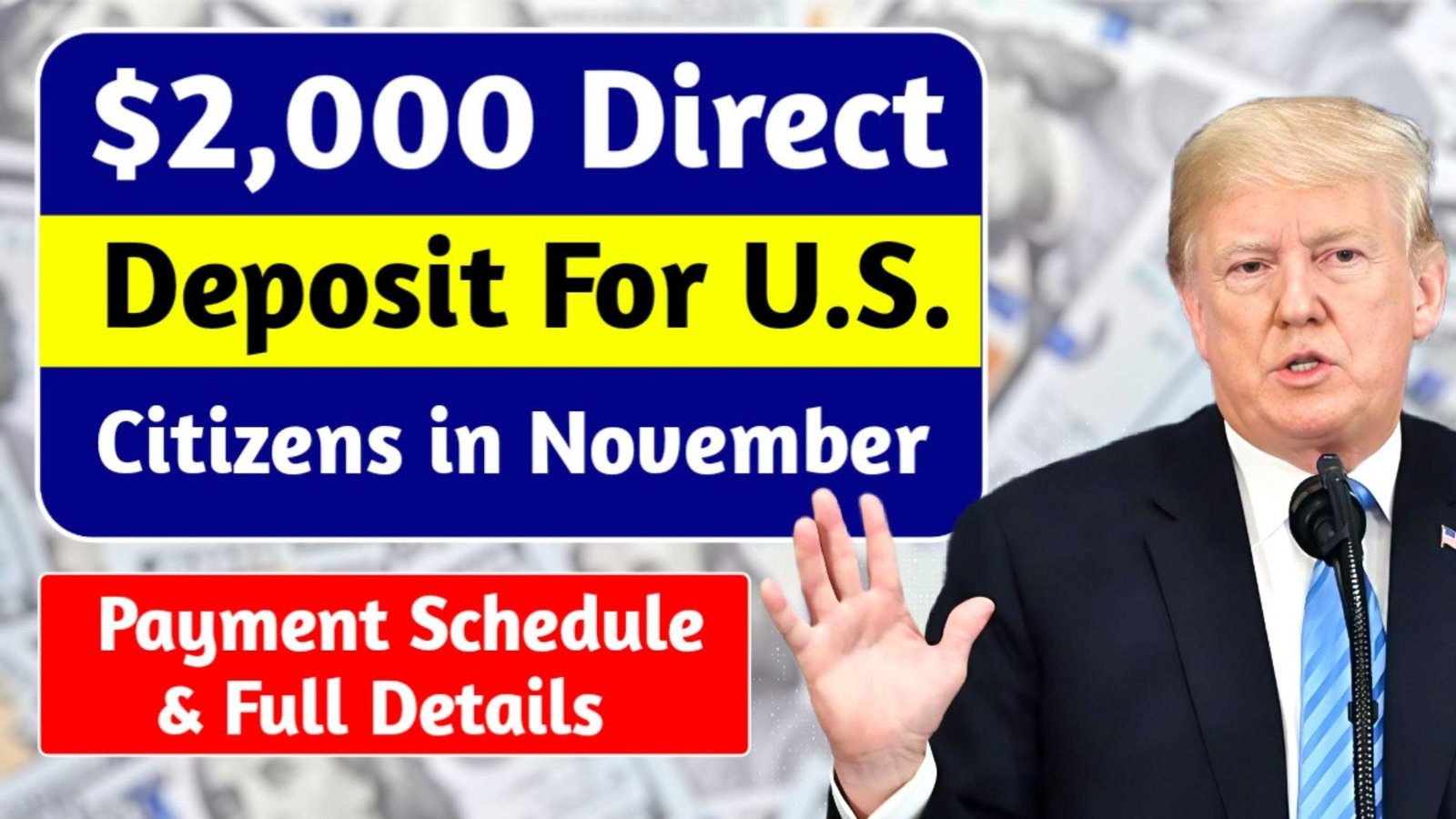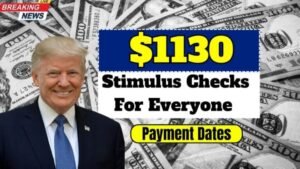In today’s tough economy, many American families are feeling the pinch from higher prices for food, housing, and everyday needs. That’s why the US government is stepping in with a helpful one-time payment of $2,000 for millions of eligible citizens this November 2025. This financial aid, handled by the Internal Revenue Service (IRS), aims to ease the burden on hardworking people and those relying on government support programs.
Think of it as a quick cash boost to cover bills, buy groceries, or handle unexpected costs just before the busy holiday season. The IRS will send the money straight to your bank account if possible, or by mail as a check if needed. No need to stress—this guide breaks it all down in easy steps. We’ll cover who gets the full amount, when the money arrives, and simple tips to make sure you don’t miss out. Whether you’re a retiree, a veteran, or a family pinching pennies, this could make a real difference.
What Is the $2,000 November 2025 Payment All About?
This $2,000 payment is like a safety net from the federal government. It’s not officially called a “stimulus check,” but it works the same way: putting money directly into people’s pockets to help with rising living costs caused by inflation and slower job growth. The goal? To give families breathing room so they can focus on what matters most.
The program targets everyday Americans who might be struggling. For example, if you’re on Social Security disability or getting help with food through government programs, you’ll likely get this automatically. It’s all based on your tax records, so keeping those up to date is key. This initiative shows the government’s commitment to supporting citizens during economic ups and downs.
Quick Facts on the Program
To make things crystal clear, here’s a simple table summarizing the basics:
| Category | Easy Explanation |
|---|---|
| Program Name | 2025 Economic Relief Payment |
| Who Runs It | IRS (the tax office that handles refunds) |
| Amount | $2,000 (one-time only) |
| How You Get It | Bank transfer or mailed check |
| When It Happens | Mid to late November 2025 |
| Who Checks It | Based on your income and citizenship |
| Official Site | IRS.gov for updates |
This table cuts through the jargon—now you know the essentials at a glance.
Who Qualifies for the Full $2,000 Payment?
Not everyone gets the money, but the rules are straightforward and fair. The IRS looks at your income from the past year, your citizenship status, and whether you’re already getting federal help. Here’s the breakdown:
Income Limits for the Full Amount
If your earnings fall below these levels, you’re in line for the complete $2,000:
| Filing Status | Maximum Income for Full Payment |
|---|---|
| Single Person | $75,000 or less |
| Married (Joint) | $150,000 or less |
| Head of Household | $112,500 or less |
What if you make a bit more? No worries—the payment doesn’t cut off completely. It reduces slowly (called a “phase-out”) as your income rises, so many middle-income folks still get something. For instance, if you’re just over the limit, you might receive $1,500 or $1,000 instead.
Automatic Qualifiers—No Extra Paperwork Needed
Some groups skip the hassle and get paid right away based on existing records:
- Social Security Recipients: This includes Supplemental Security Income (SSI) for low-income folks and Social Security Disability Insurance (SSDI) for those unable to work due to health issues.
- Veterans: Anyone getting benefits from the Veterans Affairs (VA) office qualifies.
- Low-Income Families: If you’re enrolled in SNAP (food stamps) or other aid like Medicaid, you’re covered.
To join this group, you must be a US citizen or legal permanent resident with a valid Social Security Number (SSN—a nine-digit ID for taxes and benefits) or an Individual Taxpayer Identification Number (ITIN—for non-citizens who pay taxes). Kids under 18 might qualify through parents, but the money goes to the adult filer.
In short, if you’re a law-abiding resident filing taxes honestly, chances are good you’re eligible. Over 100 million Americans could see this deposit, making it a widespread lifeline.
Payment Schedule: When Will the Money Hit Your Account?
Timing is everything, especially with holidays approaching. The IRS plans to roll out payments in batches to avoid overwhelming the system. Expect direct deposits between November 15 and November 29, 2025—that’s just two weeks to spread things out smoothly.
Breakdown by Payment Type
Here’s a handy table to track the dates:
| Payment Type | Expected Dates | Extra Notes |
|---|---|---|
| Bank Direct Deposit | November 15–29, 2025 | Fastest if your bank info is on file |
| Paper Check by Mail | Starting November 25, 2025 | For those without bank details—allow 1-2 weeks extra |
| Social Security/VA | Mid-November 2025 (possibly earlier) | Tied to your regular benefit schedule |
Pro tip: Double-check your address and bank details now. A wrong ZIP code could delay your check by weeks. If you’re a Social Security recipient, your payment might land as early as November 10, syncing with your monthly benefits.
How to Claim and Track Your $2,000 Payment Easily
Getting the money shouldn’t be a headache. Most people qualify automatically if they’ve filed recent taxes. But to play it safe, follow these four simple steps:
- File Your Taxes on Time: Even if you owe nothing or get a refund, submit your 2024 return by the deadline. Low earners can use free IRS tools like Free File.
- Update Your Info: Log into your IRS account at IRS.gov (it opens soon for 2025 updates). Add or fix your bank routing and account numbers—it’s like linking your debit card for refunds.
- Monitor Progress: Use the free “Where’s My Refund?” or “Get My Payment” tool on the IRS site. Enter your SSN, filing status, and refund amount to see real-time status.
- Watch for Scams: The IRS never asks for money upfront or sends surprise texts. If it sounds fishy, report it at IRS.gov/scams.
By doing these, you’ll join the 80% of recipients who get direct deposits without a hitch. If you’re missing info, call the IRS helpline at 1-800-829-1040—but expect wait times.
Why This $2,000 Payment Could Change Things for You
Beyond the dollars, this payment packs a punch. Imagine using it to stock up on winter clothes, fix a leaky roof, or treat your family to a holiday meal without dipping into savings. For low-income households, it’s a game-changer—covering a month’s groceries or utility bills.
Experts say it could spark wider benefits too. When families spend more, local shops thrive, jobs stay secure, and the economy picks up steam into 2026. It’s timed perfectly before Thanksgiving and Christmas, when expenses skyrocket by 20-30% on average. Retirees on fixed incomes or young parents juggling childcare will feel the relief most.
This isn’t just charity; it’s smart policy. Past relief efforts like those in 2020 showed similar payments reduced poverty by 12% temporarily. In a world of 7% inflation on basics, $2,000 buys real peace of mind.
Wrapping It Up: Act Now for Your November Boost
The $2,000 direct deposit in November 2025 is a welcome hand up for US citizens navigating tough times. From eligibility based on simple income rules to automatic perks for veterans and benefit recipients, it’s designed to be inclusive and hassle-free. Remember the key dates—November 15 to 29—and keep your IRS records fresh to avoid delays.
If you’re eligible, this could cover essentials and ease holiday stress. Head to IRS.gov today for personalized checks, and breathe easier knowing help is on the way. Stay informed, file smart, and watch your account—better days are depositing soon. For questions, the IRS site has free resources galore. You’ve got this!



